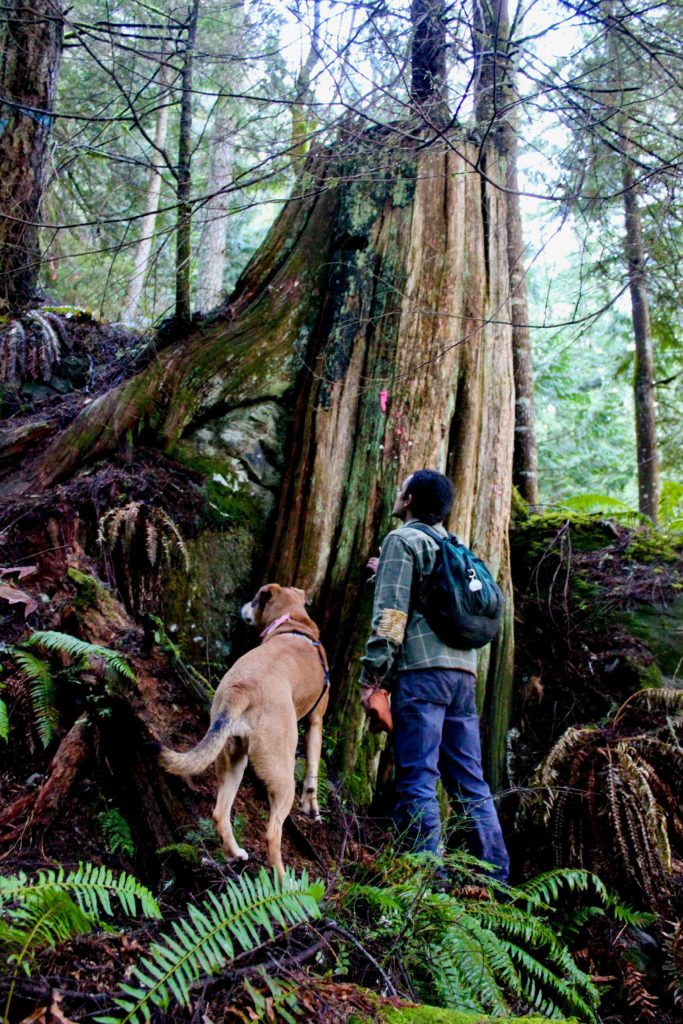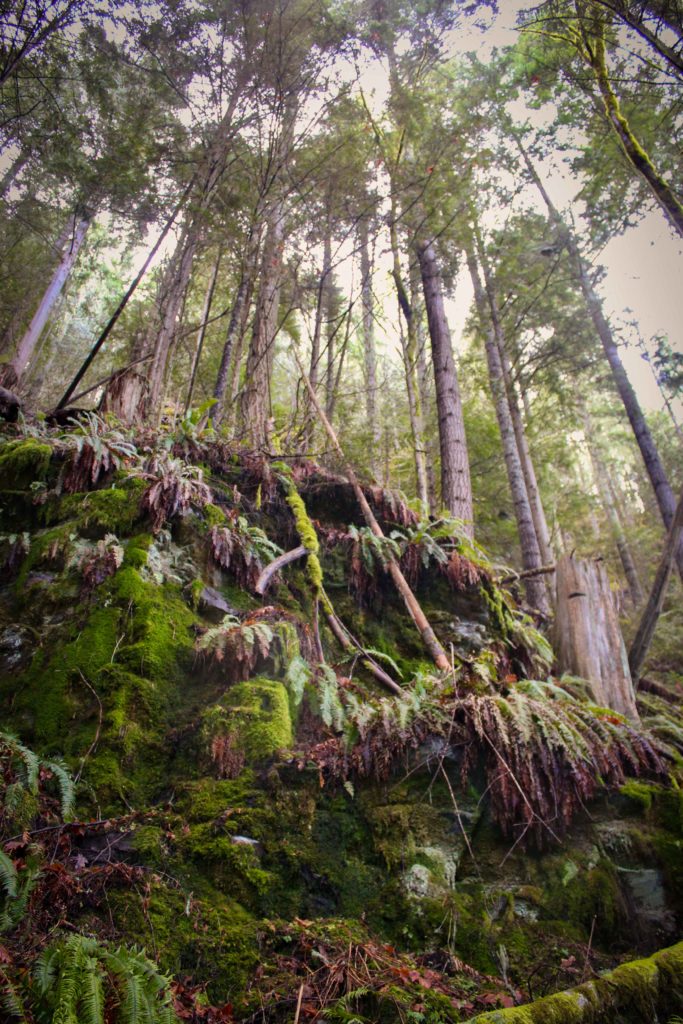Listen to the river sing sweet songs, to rock my soul”
– Brokedown Palace by The Grateful Dead
UPDATE December 18th, 2023 — The Department of Natural Resources (DNR) today announced the protection of 2,000 acres of largely mature, structurally-complex forests, often referred to as legacy forests, across western Washington as part of a state investment in climate adaptation and carbon storage. Included in the 650 conserved forestland in Whatcom County are the 75 acres of Brokedown Palace. Thank you for your advocacy!
UPDATE: June 6, 2023 — DNR just announced that they’re pausing the Brokedown Palace Timber Sale for a second time. This pause will allow time for this mature, naturally-regenerated forest to be evaluated for protection under Washington’s new Climate Commitment Act (CCA) program.
Just above the Middle Fork Nooksack River lies a grove of century-old conifers and steep headwall cliffs. From the stand, you can hear the Middle Fork roar below as it cascades through a canyon with jagged bedrock walls and smooth volcanic river rock. This is the Brokedown Palace Forest.
Now the forest is on the chopping block. On February 3rd, the Washington Department of Natural Resources (DNR) announced its plan to clearcut this publicly owned forest in the next 1-2 years. Without community action, this legacy forest will be clearcut and converted into a tree plantation, which would be a major loss for the Middle Fork watershed and our community. Preserving mature forests provides us with many essential services for free, like watershed protection, steep slope stabilization, carbon storage, and wildlife habitat.
Contact DNR to tell them the Brokedown Palace Forest is worth more standing. Ask DNR to cancel this timber sale — or at the very least to pause while the legislature explores three separate pathways to protect forests just like this.
Legacy forests like Brokedown Palace: the old-growth of the future

The majority of this 69-acre timber sale is made up of “legacy forest” that naturally regenerated after the forest was logged sometime in the 1920s. Legacy forests are very different from the tree plantations that blanket most of the Mt Baker Foothills. Plantations are young, homogenous, simple, and tightly packed together. But legacy forests are biodiverse, structurally complex, and well on their way to becoming fully functioning old-growth forests.
One of the features that makes Brokedown Palace Forest so unique is its structural complexity, meaning it has a mix of large, medium, and small trees, as well as shrubs, snags, and fallen wood that are very important for wildlife. The sale includes some fallen old-growth logs that may have been seedlings before the signing of the Declaration of Independence, and the sale borders a stand of old-growth that has never been logged. If protected from clearcut logging, this stand will pass down a biological legacy to the next generation of forest species that inherit this forest.
Clearcutting harms the Middle Fork’s water quality and increases flood risk
Perhaps what’s most concerning about this timber sale is the risk it poses to the Middle Fork below. This hillside is very steep—the timber sale includes slopes up to 150%. That’s practically a cliff. Clearcutting and road building on steep slopes like these will:
- Remove the mature forest canopy that intercepts and slows down rainfall
- Eliminate the root network that stabilizes the soil; and
- Increase the amount of water loading the steep, unstable slopes below.
Taken together, these impacts will likely increase the risks of landslides and erosion that could deliver sediment into the Middle Fork. Whatcom County has a long history of logging-related landslides, which have played a significant role in degrading rivers and streams. Past logging and associated road construction have increased seasonal high flows in the Nooksack watershed, which has degraded salmon habitat and water quality, and has even changed the shape of our rivers (Nooksack Indian Tribe 2017; Department of Ecology 2017).
Current logging rules are much better than they used to be, and it’s important to recognize that DNR manages its forestland better than many private logging companies in our neck of the proverbial woods. But frankly, the rules governing steep slope logging are insufficient. While scientists were consulted, the rules ultimately represent political compromises that achieve the bare minimum protections.

If Brokedown were the only forest clearcut in Whatcom County this year, these hydrologic concerns would be minor; however, many thousands of acres of private and state-owned forestland are clearcut, sprayed, and replanted in the Mt Baker Foothills every year. Scientists have found that industrial logging practices at watershed-scale can degrade water quality, increase winter high flows, and destroy salmon habitat (Tschaplinski & Pike 2016; Grant et al. 2008; Jones & Grant 1996). Additionally, research conducted in the Pacific Northwest shows that industrial logging practices can reduce summer streamflows by as much as 50% compared to adjacent watersheds with mature forest cover (Segura et al. 2020; Perry & Jones 2017). Late summer is when farmers and salmon both need water the most.
Managing our forests for climate resilience
Researchers project that climate change will harm the Puget Sound region by decreasing snowpack and reducing summer streamflows while simultaneously increasing extreme rainfall events, landslides, turbidity, and flooding other times of the year (Dalton et al. 2013; Warner et al. 2015; Mauger et al. 2015). Researchers at Western Washington University estimate that by 2075, the Middle Fork’s winter flows will double compared to historic streamflows, increasing by 93% to 127% (depending on emissions scenarios) (Murphy 2016). Conversely, the researchers expect climate change to diminish the Middle Fork’s summer streamflows by 52% to 65%.
In other words, when today’s high schoolers are nearing retirement age, the hydrology of the Middle Fork will have completely transformed. Legacy forests like Brokedown Palace can help alleviate the high and low flows associated with climate change, and also lower the risks of landslides and sediment delivery to the Middle Fork. Forests operate on a scale of decades to centuries, which means forest management decisions must account for the climate conditions 50-100 years from now. Unfortunately, current DNR policies do not account for these future climate impacts in any meaningful way.

In addition to bolstering the resilience of the Middle Fork watershed and downstream communities, mature forests like Brokedown Palace excel at capturing and storing carbon for long periods of time, keeping it out of the atmosphere and thereby mitigating global climate change (Law et al. 2018). A recent study found that improved forest management strategies could play a major role in helping our state meet its climate goals (Robertson et al. 2021). Research shows that mature and old-growth forests continue to act as net carbon sinks even into their old age, meaning they continue to sequester and store more carbon than they emit (Hudiburg et al. 2009). Clearcutting mature forests and milling trees into paper and wood products results in the rapid release of most of the original forest’s stored carbon (Harmon 2019; Hudiburg et al. 2019).
The urgency of the climate crisis requires us to challenge old assumptions and proactively adjust our forest management strategies. That doesn’t mean we “lock up” our forestlands from any kind of forest management. RE Sources supports active forest management strategies that support jobs in the woods and sustainable wood production while bolstering other benefits that our forests provide, such as watershed regulation, wildlife habitat, carbon storage, recreation, and cultural uses. To understand why we support “Ecological Forest Management,” check out the video we made with preeminent forest ecologist Dr. Jerry Franklin.
Brokedown Palace would be a prime candidate for Washington’s carbon projects
Governor Jay Inslee recognized the importance of protecting legacy forest in his proposed legislative budget, which earmarks money generated through Washington’s new Cap & Invest Program to conserve “carbon dense and structurally complex” forests on state lands. Also, DNR recently announced a new bill that would grant the agency the authority to generate revenue for its beneficiaries by monetizing ecosystem services (like DNR’s pilot carbon project). An additional bill would revitalize DNR’s Trustland Transfer Program, making it more transparent, regular, and efficient and protecting key parcels while ensuring the beneficiaries are made whole.
Brokedown Palace would be a prime candidate for each of these programs. At the very least, DNR should pause this timber sale to consider the range of options that the legislature may make available in the months ahead. Additional time may also give DNR the ability to consider alternative prescriptions other than clearcutting (such as selective thinning or variable density thinning), which would mitigate the negative impacts logging would have.
In all, we believe this forest is worth more standing. Please contact DNR and ask them to cancel — or at the very least pause — this timber sale while the legislature provides direction for how the agency should manage legacy forests like Brokedown Palace.
Learn more about Brokedown Palace
Forest Practices Application (this includes maps)
SEPA Checklist (this includes maps)


